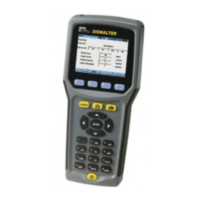SIGNALTEK Operation Manual 5-5
packet errors, indicating that the bit error test was 100%
successful.
Performance Test Failures
Errors during the performance tests indicate a potential problem
with the cabling, connectors or installation environment. The typical
cause for errors is a low signal to noise ratio (SNR) or low
attenuation to crosstalk ratio (ACR), meaning that crosstalk (ACR)
or external noise (SNR) is at a level that the gigabit noise canceling
circuitry cannot remedy.
The first step in troubleshooting a performance test failure is to
check the quality of the termination at the work station and patch
panel. Installation guidelines allow for no more than ½” of untwist in
each pair and no more than 1” of jacket to be removed at each
termination. Excessive untwisting can lead to high Near End
Crosstalk (NEXT) within the cable and an unacceptable ACR.
Ensure that all the components in the cabling system are rated to
at least Category 5e or ISO Class D by the manufacturer. Lesser
quality components may not provide the necessary performance
margins required for successful gigabit Ethernet operation. Also
check that the equipment patch cords are also rated to Cat5e/ISO-
D and that the RJ-45 modular plugs are terminated in accordance
with the TIA-568 A/B specification (see Figure 1-1). Some low-
quality patch cords are terminated with a “straight through”
configuration that causes excessive crosstalk and will not support
operation at gigabit or sometimes even 100Mbps data rates.
The IEEE specifies the maximum operational distance limit of
10/100/1000 Mbps Ethernet as 100m (328ft). While it is possible
for a link to operate at greater distances, the attenuation of the link
increases in direct proportion to the length. Another factor affecting
the SNR is the temperature of the cable: as the temperature
increases, so does the attenuation of the cable. Accordingly, in
very hot locations, links at 100m or less in length may still exhibit

